LIBS1990 Fall 2018: Report on Current/Recent Natural Disasters
VerifiedAdded on 2023/05/30
|8
|1625
|219
Report
AI Summary
This report examines recent natural disasters, focusing on the Gorkha Earthquake, the 2011 Japan Tsunami, and Hurricane Harvey. The analysis includes the dates, geographical locations, and impacts of each disaster. The Gorkha Earthquake, a 7.8 magnitude event in Nepal, caused widespread destruction and fatalities, highlighting the region's vulnerability due to its location between tectonic plates. The 2011 Japan Tsunami, triggered by a 9.0M earthquake, led to immense devastation, including the Fukushima nuclear disaster, and exposed shortcomings in early warning systems. Hurricane Harvey, impacting the Houston metropolitan area, caused extensive flooding and property damage, prompting discussions on climate change and mitigation strategies. The report concludes with recommendations for disaster preparedness, including improved infrastructure, retrofitting buildings, and enhanced evacuation procedures. This document is available on Desklib, a platform offering a wide range of study resources, including past papers and solved assignments, for students.
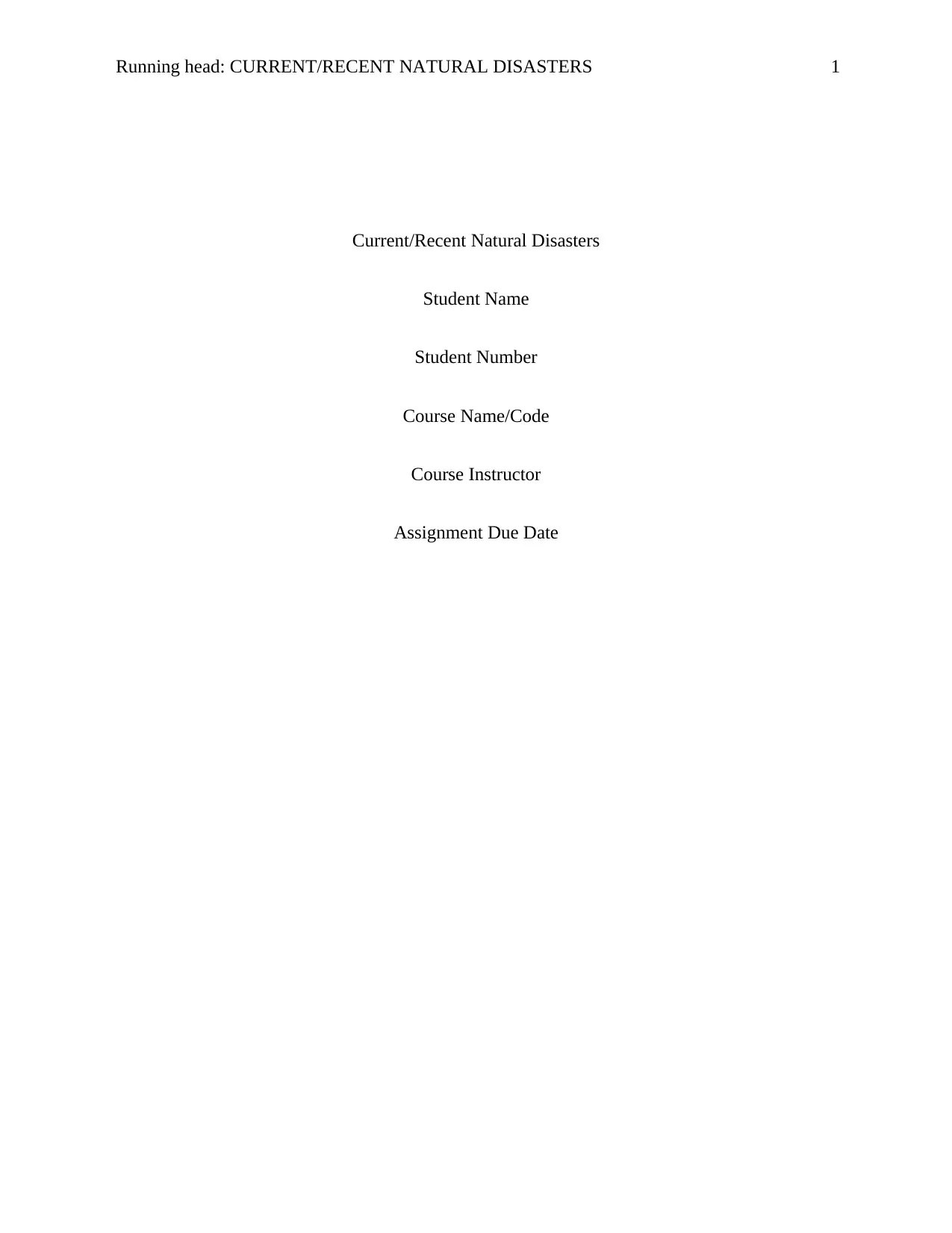
Running head: CURRENT/RECENT NATURAL DISASTERS 1
Current/Recent Natural Disasters
Student Name
Student Number
Course Name/Code
Course Instructor
Assignment Due Date
Current/Recent Natural Disasters
Student Name
Student Number
Course Name/Code
Course Instructor
Assignment Due Date
Paraphrase This Document
Need a fresh take? Get an instant paraphrase of this document with our AI Paraphraser
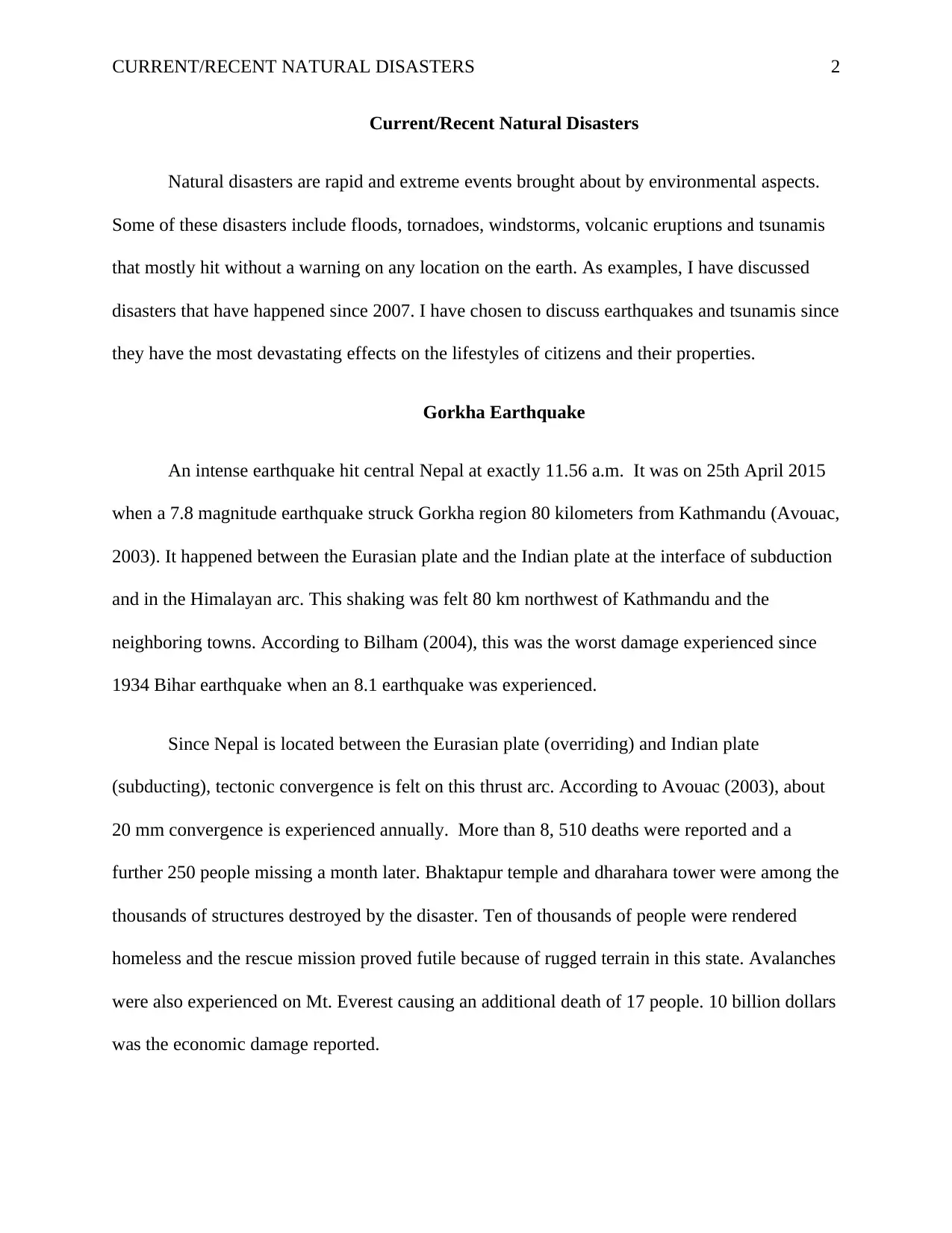
CURRENT/RECENT NATURAL DISASTERS 2
Current/Recent Natural Disasters
Natural disasters are rapid and extreme events brought about by environmental aspects.
Some of these disasters include floods, tornadoes, windstorms, volcanic eruptions and tsunamis
that mostly hit without a warning on any location on the earth. As examples, I have discussed
disasters that have happened since 2007. I have chosen to discuss earthquakes and tsunamis since
they have the most devastating effects on the lifestyles of citizens and their properties.
Gorkha Earthquake
An intense earthquake hit central Nepal at exactly 11.56 a.m. It was on 25th April 2015
when a 7.8 magnitude earthquake struck Gorkha region 80 kilometers from Kathmandu (Avouac,
2003). It happened between the Eurasian plate and the Indian plate at the interface of subduction
and in the Himalayan arc. This shaking was felt 80 km northwest of Kathmandu and the
neighboring towns. According to Bilham (2004), this was the worst damage experienced since
1934 Bihar earthquake when an 8.1 earthquake was experienced.
Since Nepal is located between the Eurasian plate (overriding) and Indian plate
(subducting), tectonic convergence is felt on this thrust arc. According to Avouac (2003), about
20 mm convergence is experienced annually. More than 8, 510 deaths were reported and a
further 250 people missing a month later. Bhaktapur temple and dharahara tower were among the
thousands of structures destroyed by the disaster. Ten of thousands of people were rendered
homeless and the rescue mission proved futile because of rugged terrain in this state. Avalanches
were also experienced on Mt. Everest causing an additional death of 17 people. 10 billion dollars
was the economic damage reported.
Current/Recent Natural Disasters
Natural disasters are rapid and extreme events brought about by environmental aspects.
Some of these disasters include floods, tornadoes, windstorms, volcanic eruptions and tsunamis
that mostly hit without a warning on any location on the earth. As examples, I have discussed
disasters that have happened since 2007. I have chosen to discuss earthquakes and tsunamis since
they have the most devastating effects on the lifestyles of citizens and their properties.
Gorkha Earthquake
An intense earthquake hit central Nepal at exactly 11.56 a.m. It was on 25th April 2015
when a 7.8 magnitude earthquake struck Gorkha region 80 kilometers from Kathmandu (Avouac,
2003). It happened between the Eurasian plate and the Indian plate at the interface of subduction
and in the Himalayan arc. This shaking was felt 80 km northwest of Kathmandu and the
neighboring towns. According to Bilham (2004), this was the worst damage experienced since
1934 Bihar earthquake when an 8.1 earthquake was experienced.
Since Nepal is located between the Eurasian plate (overriding) and Indian plate
(subducting), tectonic convergence is felt on this thrust arc. According to Avouac (2003), about
20 mm convergence is experienced annually. More than 8, 510 deaths were reported and a
further 250 people missing a month later. Bhaktapur temple and dharahara tower were among the
thousands of structures destroyed by the disaster. Ten of thousands of people were rendered
homeless and the rescue mission proved futile because of rugged terrain in this state. Avalanches
were also experienced on Mt. Everest causing an additional death of 17 people. 10 billion dollars
was the economic damage reported.
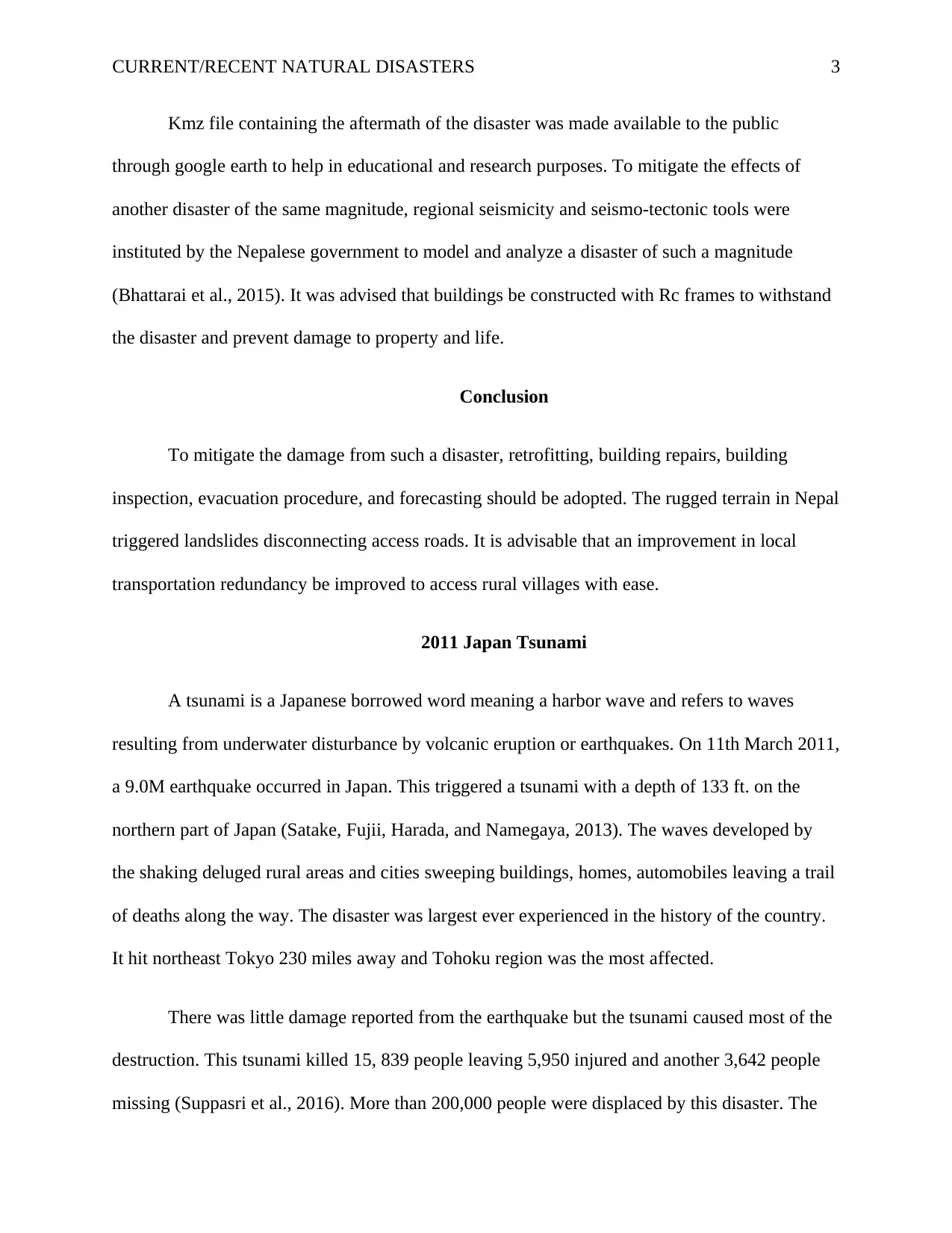
CURRENT/RECENT NATURAL DISASTERS 3
Kmz file containing the aftermath of the disaster was made available to the public
through google earth to help in educational and research purposes. To mitigate the effects of
another disaster of the same magnitude, regional seismicity and seismo-tectonic tools were
instituted by the Nepalese government to model and analyze a disaster of such a magnitude
(Bhattarai et al., 2015). It was advised that buildings be constructed with Rc frames to withstand
the disaster and prevent damage to property and life.
Conclusion
To mitigate the damage from such a disaster, retrofitting, building repairs, building
inspection, evacuation procedure, and forecasting should be adopted. The rugged terrain in Nepal
triggered landslides disconnecting access roads. It is advisable that an improvement in local
transportation redundancy be improved to access rural villages with ease.
2011 Japan Tsunami
A tsunami is a Japanese borrowed word meaning a harbor wave and refers to waves
resulting from underwater disturbance by volcanic eruption or earthquakes. On 11th March 2011,
a 9.0M earthquake occurred in Japan. This triggered a tsunami with a depth of 133 ft. on the
northern part of Japan (Satake, Fujii, Harada, and Namegaya, 2013). The waves developed by
the shaking deluged rural areas and cities sweeping buildings, homes, automobiles leaving a trail
of deaths along the way. The disaster was largest ever experienced in the history of the country.
It hit northeast Tokyo 230 miles away and Tohoku region was the most affected.
There was little damage reported from the earthquake but the tsunami caused most of the
destruction. This tsunami killed 15, 839 people leaving 5,950 injured and another 3,642 people
missing (Suppasri et al., 2016). More than 200,000 people were displaced by this disaster. The
Kmz file containing the aftermath of the disaster was made available to the public
through google earth to help in educational and research purposes. To mitigate the effects of
another disaster of the same magnitude, regional seismicity and seismo-tectonic tools were
instituted by the Nepalese government to model and analyze a disaster of such a magnitude
(Bhattarai et al., 2015). It was advised that buildings be constructed with Rc frames to withstand
the disaster and prevent damage to property and life.
Conclusion
To mitigate the damage from such a disaster, retrofitting, building repairs, building
inspection, evacuation procedure, and forecasting should be adopted. The rugged terrain in Nepal
triggered landslides disconnecting access roads. It is advisable that an improvement in local
transportation redundancy be improved to access rural villages with ease.
2011 Japan Tsunami
A tsunami is a Japanese borrowed word meaning a harbor wave and refers to waves
resulting from underwater disturbance by volcanic eruption or earthquakes. On 11th March 2011,
a 9.0M earthquake occurred in Japan. This triggered a tsunami with a depth of 133 ft. on the
northern part of Japan (Satake, Fujii, Harada, and Namegaya, 2013). The waves developed by
the shaking deluged rural areas and cities sweeping buildings, homes, automobiles leaving a trail
of deaths along the way. The disaster was largest ever experienced in the history of the country.
It hit northeast Tokyo 230 miles away and Tohoku region was the most affected.
There was little damage reported from the earthquake but the tsunami caused most of the
destruction. This tsunami killed 15, 839 people leaving 5,950 injured and another 3,642 people
missing (Suppasri et al., 2016). More than 200,000 people were displaced by this disaster. The
⊘ This is a preview!⊘
Do you want full access?
Subscribe today to unlock all pages.

Trusted by 1+ million students worldwide
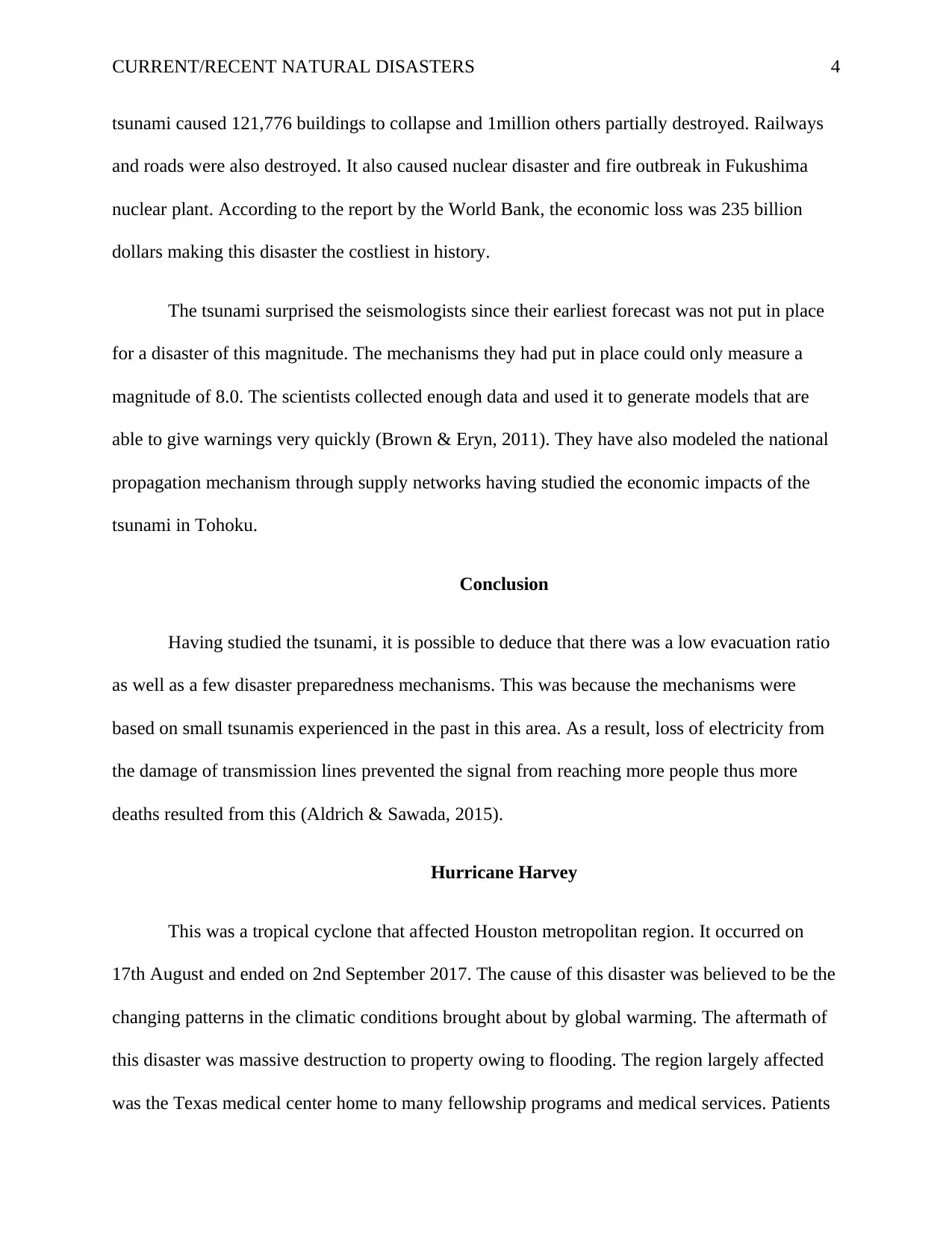
CURRENT/RECENT NATURAL DISASTERS 4
tsunami caused 121,776 buildings to collapse and 1million others partially destroyed. Railways
and roads were also destroyed. It also caused nuclear disaster and fire outbreak in Fukushima
nuclear plant. According to the report by the World Bank, the economic loss was 235 billion
dollars making this disaster the costliest in history.
The tsunami surprised the seismologists since their earliest forecast was not put in place
for a disaster of this magnitude. The mechanisms they had put in place could only measure a
magnitude of 8.0. The scientists collected enough data and used it to generate models that are
able to give warnings very quickly (Brown & Eryn, 2011). They have also modeled the national
propagation mechanism through supply networks having studied the economic impacts of the
tsunami in Tohoku.
Conclusion
Having studied the tsunami, it is possible to deduce that there was a low evacuation ratio
as well as a few disaster preparedness mechanisms. This was because the mechanisms were
based on small tsunamis experienced in the past in this area. As a result, loss of electricity from
the damage of transmission lines prevented the signal from reaching more people thus more
deaths resulted from this (Aldrich & Sawada, 2015).
Hurricane Harvey
This was a tropical cyclone that affected Houston metropolitan region. It occurred on
17th August and ended on 2nd September 2017. The cause of this disaster was believed to be the
changing patterns in the climatic conditions brought about by global warming. The aftermath of
this disaster was massive destruction to property owing to flooding. The region largely affected
was the Texas medical center home to many fellowship programs and medical services. Patients
tsunami caused 121,776 buildings to collapse and 1million others partially destroyed. Railways
and roads were also destroyed. It also caused nuclear disaster and fire outbreak in Fukushima
nuclear plant. According to the report by the World Bank, the economic loss was 235 billion
dollars making this disaster the costliest in history.
The tsunami surprised the seismologists since their earliest forecast was not put in place
for a disaster of this magnitude. The mechanisms they had put in place could only measure a
magnitude of 8.0. The scientists collected enough data and used it to generate models that are
able to give warnings very quickly (Brown & Eryn, 2011). They have also modeled the national
propagation mechanism through supply networks having studied the economic impacts of the
tsunami in Tohoku.
Conclusion
Having studied the tsunami, it is possible to deduce that there was a low evacuation ratio
as well as a few disaster preparedness mechanisms. This was because the mechanisms were
based on small tsunamis experienced in the past in this area. As a result, loss of electricity from
the damage of transmission lines prevented the signal from reaching more people thus more
deaths resulted from this (Aldrich & Sawada, 2015).
Hurricane Harvey
This was a tropical cyclone that affected Houston metropolitan region. It occurred on
17th August and ended on 2nd September 2017. The cause of this disaster was believed to be the
changing patterns in the climatic conditions brought about by global warming. The aftermath of
this disaster was massive destruction to property owing to flooding. The region largely affected
was the Texas medical center home to many fellowship programs and medical services. Patients
Paraphrase This Document
Need a fresh take? Get an instant paraphrase of this document with our AI Paraphraser
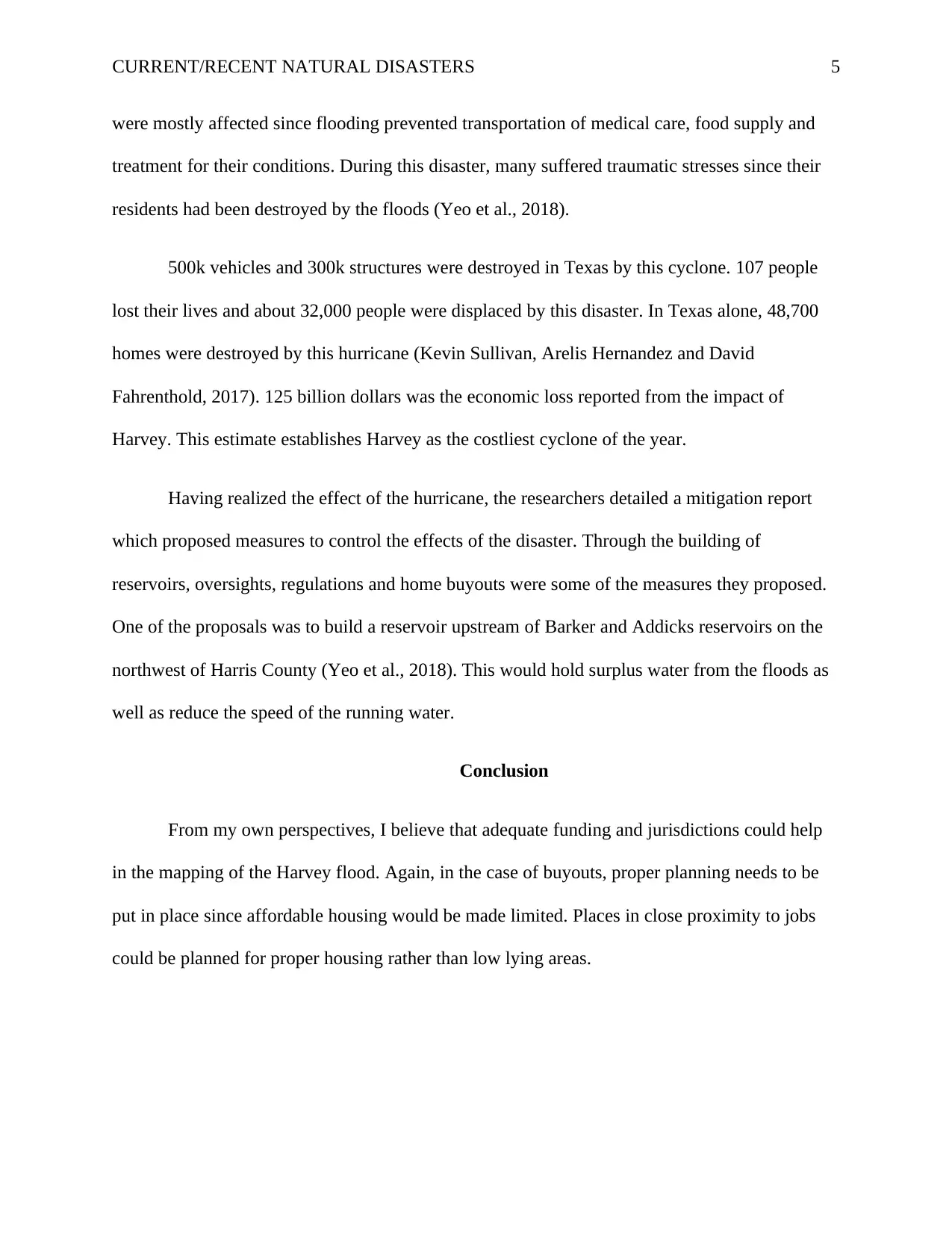
CURRENT/RECENT NATURAL DISASTERS 5
were mostly affected since flooding prevented transportation of medical care, food supply and
treatment for their conditions. During this disaster, many suffered traumatic stresses since their
residents had been destroyed by the floods (Yeo et al., 2018).
500k vehicles and 300k structures were destroyed in Texas by this cyclone. 107 people
lost their lives and about 32,000 people were displaced by this disaster. In Texas alone, 48,700
homes were destroyed by this hurricane (Kevin Sullivan, Arelis Hernandez and David
Fahrenthold, 2017). 125 billion dollars was the economic loss reported from the impact of
Harvey. This estimate establishes Harvey as the costliest cyclone of the year.
Having realized the effect of the hurricane, the researchers detailed a mitigation report
which proposed measures to control the effects of the disaster. Through the building of
reservoirs, oversights, regulations and home buyouts were some of the measures they proposed.
One of the proposals was to build a reservoir upstream of Barker and Addicks reservoirs on the
northwest of Harris County (Yeo et al., 2018). This would hold surplus water from the floods as
well as reduce the speed of the running water.
Conclusion
From my own perspectives, I believe that adequate funding and jurisdictions could help
in the mapping of the Harvey flood. Again, in the case of buyouts, proper planning needs to be
put in place since affordable housing would be made limited. Places in close proximity to jobs
could be planned for proper housing rather than low lying areas.
were mostly affected since flooding prevented transportation of medical care, food supply and
treatment for their conditions. During this disaster, many suffered traumatic stresses since their
residents had been destroyed by the floods (Yeo et al., 2018).
500k vehicles and 300k structures were destroyed in Texas by this cyclone. 107 people
lost their lives and about 32,000 people were displaced by this disaster. In Texas alone, 48,700
homes were destroyed by this hurricane (Kevin Sullivan, Arelis Hernandez and David
Fahrenthold, 2017). 125 billion dollars was the economic loss reported from the impact of
Harvey. This estimate establishes Harvey as the costliest cyclone of the year.
Having realized the effect of the hurricane, the researchers detailed a mitigation report
which proposed measures to control the effects of the disaster. Through the building of
reservoirs, oversights, regulations and home buyouts were some of the measures they proposed.
One of the proposals was to build a reservoir upstream of Barker and Addicks reservoirs on the
northwest of Harris County (Yeo et al., 2018). This would hold surplus water from the floods as
well as reduce the speed of the running water.
Conclusion
From my own perspectives, I believe that adequate funding and jurisdictions could help
in the mapping of the Harvey flood. Again, in the case of buyouts, proper planning needs to be
put in place since affordable housing would be made limited. Places in close proximity to jobs
could be planned for proper housing rather than low lying areas.

CURRENT/RECENT NATURAL DISASTERS 6
⊘ This is a preview!⊘
Do you want full access?
Subscribe today to unlock all pages.

Trusted by 1+ million students worldwide
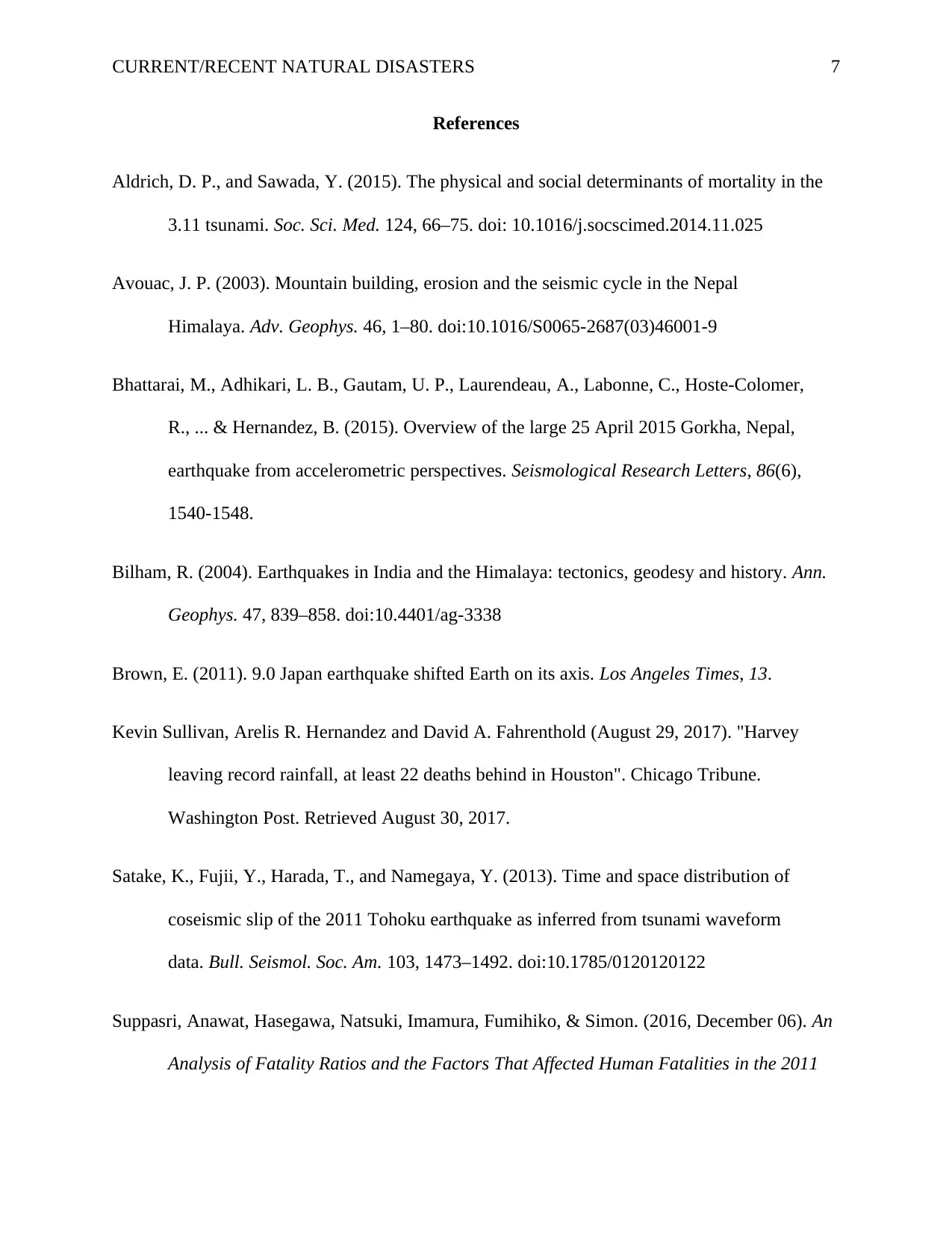
CURRENT/RECENT NATURAL DISASTERS 7
References
Aldrich, D. P., and Sawada, Y. (2015). The physical and social determinants of mortality in the
3.11 tsunami. Soc. Sci. Med. 124, 66–75. doi: 10.1016/j.socscimed.2014.11.025
Avouac, J. P. (2003). Mountain building, erosion and the seismic cycle in the Nepal
Himalaya. Adv. Geophys. 46, 1–80. doi:10.1016/S0065-2687(03)46001-9
Bhattarai, M., Adhikari, L. B., Gautam, U. P., Laurendeau, A., Labonne, C., Hoste-Colomer,
R., ... & Hernandez, B. (2015). Overview of the large 25 April 2015 Gorkha, Nepal,
earthquake from accelerometric perspectives. Seismological Research Letters, 86(6),
1540-1548.
Bilham, R. (2004). Earthquakes in India and the Himalaya: tectonics, geodesy and history. Ann.
Geophys. 47, 839–858. doi:10.4401/ag-3338
Brown, E. (2011). 9.0 Japan earthquake shifted Earth on its axis. Los Angeles Times, 13.
Kevin Sullivan, Arelis R. Hernandez and David A. Fahrenthold (August 29, 2017). "Harvey
leaving record rainfall, at least 22 deaths behind in Houston". Chicago Tribune.
Washington Post. Retrieved August 30, 2017.
Satake, K., Fujii, Y., Harada, T., and Namegaya, Y. (2013). Time and space distribution of
coseismic slip of the 2011 Tohoku earthquake as inferred from tsunami waveform
data. Bull. Seismol. Soc. Am. 103, 1473–1492. doi:10.1785/0120120122
Suppasri, Anawat, Hasegawa, Natsuki, Imamura, Fumihiko, & Simon. (2016, December 06). An
Analysis of Fatality Ratios and the Factors That Affected Human Fatalities in the 2011
References
Aldrich, D. P., and Sawada, Y. (2015). The physical and social determinants of mortality in the
3.11 tsunami. Soc. Sci. Med. 124, 66–75. doi: 10.1016/j.socscimed.2014.11.025
Avouac, J. P. (2003). Mountain building, erosion and the seismic cycle in the Nepal
Himalaya. Adv. Geophys. 46, 1–80. doi:10.1016/S0065-2687(03)46001-9
Bhattarai, M., Adhikari, L. B., Gautam, U. P., Laurendeau, A., Labonne, C., Hoste-Colomer,
R., ... & Hernandez, B. (2015). Overview of the large 25 April 2015 Gorkha, Nepal,
earthquake from accelerometric perspectives. Seismological Research Letters, 86(6),
1540-1548.
Bilham, R. (2004). Earthquakes in India and the Himalaya: tectonics, geodesy and history. Ann.
Geophys. 47, 839–858. doi:10.4401/ag-3338
Brown, E. (2011). 9.0 Japan earthquake shifted Earth on its axis. Los Angeles Times, 13.
Kevin Sullivan, Arelis R. Hernandez and David A. Fahrenthold (August 29, 2017). "Harvey
leaving record rainfall, at least 22 deaths behind in Houston". Chicago Tribune.
Washington Post. Retrieved August 30, 2017.
Satake, K., Fujii, Y., Harada, T., and Namegaya, Y. (2013). Time and space distribution of
coseismic slip of the 2011 Tohoku earthquake as inferred from tsunami waveform
data. Bull. Seismol. Soc. Am. 103, 1473–1492. doi:10.1785/0120120122
Suppasri, Anawat, Hasegawa, Natsuki, Imamura, Fumihiko, & Simon. (2016, December 06). An
Analysis of Fatality Ratios and the Factors That Affected Human Fatalities in the 2011
Paraphrase This Document
Need a fresh take? Get an instant paraphrase of this document with our AI Paraphraser
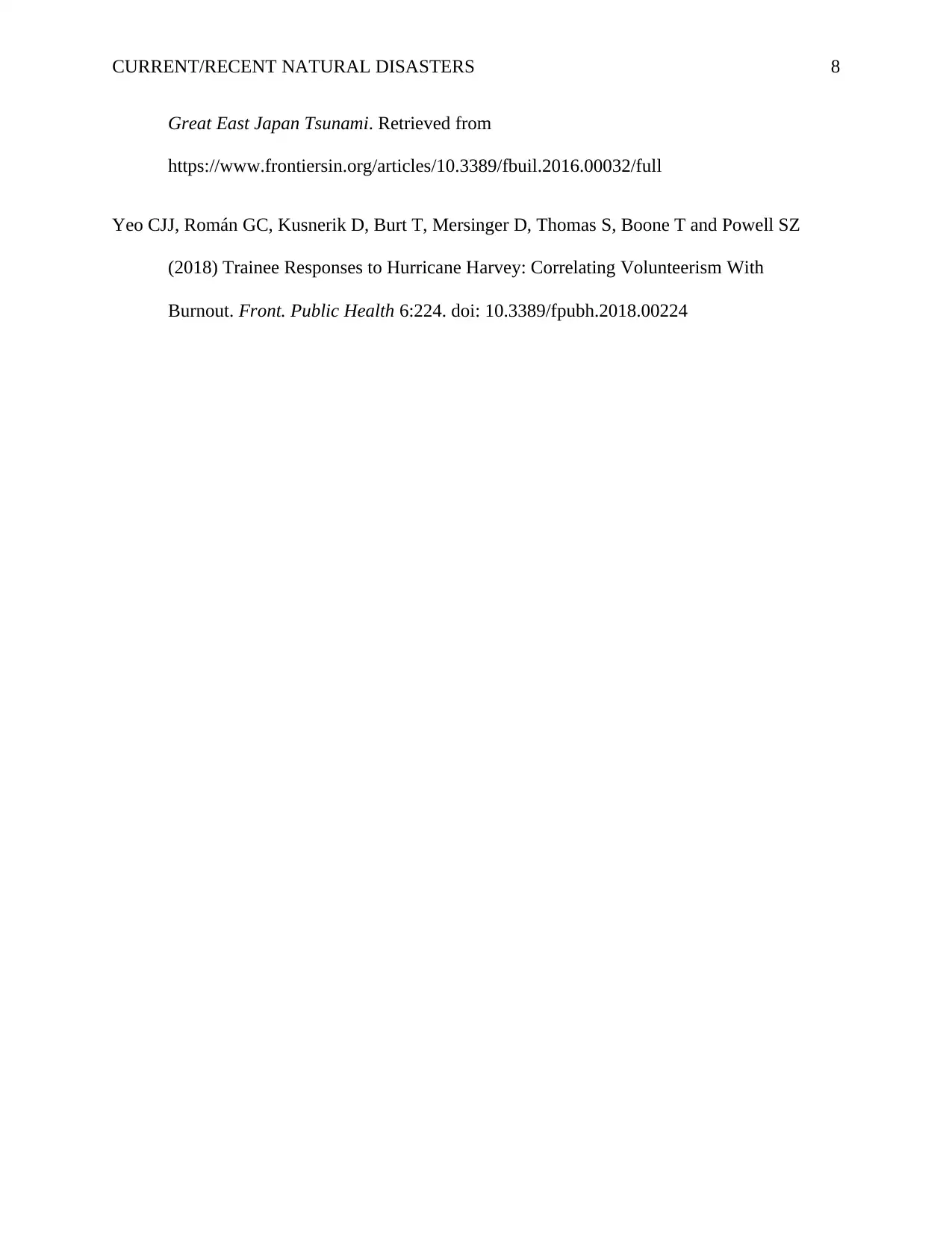
CURRENT/RECENT NATURAL DISASTERS 8
Great East Japan Tsunami. Retrieved from
https://www.frontiersin.org/articles/10.3389/fbuil.2016.00032/full
Yeo CJJ, Román GC, Kusnerik D, Burt T, Mersinger D, Thomas S, Boone T and Powell SZ
(2018) Trainee Responses to Hurricane Harvey: Correlating Volunteerism With
Burnout. Front. Public Health 6:224. doi: 10.3389/fpubh.2018.00224
Great East Japan Tsunami. Retrieved from
https://www.frontiersin.org/articles/10.3389/fbuil.2016.00032/full
Yeo CJJ, Román GC, Kusnerik D, Burt T, Mersinger D, Thomas S, Boone T and Powell SZ
(2018) Trainee Responses to Hurricane Harvey: Correlating Volunteerism With
Burnout. Front. Public Health 6:224. doi: 10.3389/fpubh.2018.00224
1 out of 8
Your All-in-One AI-Powered Toolkit for Academic Success.
+13062052269
info@desklib.com
Available 24*7 on WhatsApp / Email
![[object Object]](/_next/static/media/star-bottom.7253800d.svg)
Unlock your academic potential
Copyright © 2020–2025 A2Z Services. All Rights Reserved. Developed and managed by ZUCOL.


